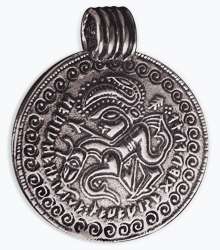Seeland-II-C
Seeland-II-C (Sjælland bracteate 2) is a Scandinavian bracteate from Zealand, Denmark, that has been dated to the Migration period (around 500 AD). The bracteate bears an Elder Futhark inscription which reads as:
- hariuha haitika : farauisa : gibu auja : ttt

The final ttt is a triple-stacked Tiwaz rune. This use of the rune is often interpreted as three invocations of the Norse pagan god Tyr.[1]
The central image shows a male's head above a quadruped. This is the defining characteristic of C-bracteates (of which some 400 specimens survive), and is often interpreted as a depiction of the god Odin, healing his horse.
David W. Krause translates the inscription as: "Hariuha I am called: the dangerous knowledgeable one: I give chance."[2] farauisa is interpreted as fara-uisa, either "danger-wise" or "travel-wise". Erik Moltke translates this word as "one who is wise about dangers".[3] The giving of "chance" or "luck" in the inscription is evidence of the use of bracteates as amulets.[4]
See also
- Merseburg Incantations
- Vadstena bracteate
References
- Spurkland, Terje (2005). Norwegian Runes and Runic Inscriptions. Boydell Press. p. 12. ISBN 1-84383-186-4.
- Krause, W. (1971). Die Sprache der Urnordischen Runeninschriften. ISBN 3-533-02179-3.
- Moltke, Erik (1976). Runerne i Danmark og deres Oprindelse. ISBN 87-553-0426-5. Published in English as Runes and their Origin: Denmark and Elsewhere.
- Looijenga, Tineke (2003). Texts and Contexts of the Oldest Runic Inscriptions. Brill. p. 213. ISBN 90-04-12396-2.
External links
- Kodratoff, Yves. Runic Inscriptions (Transcriptions with interpretations by Krause, Moltke, Antonsen and the author; see Runic Inscriptions from the Second Period no. 81).